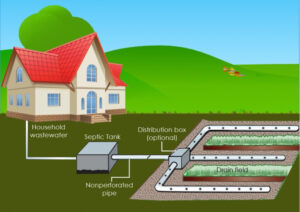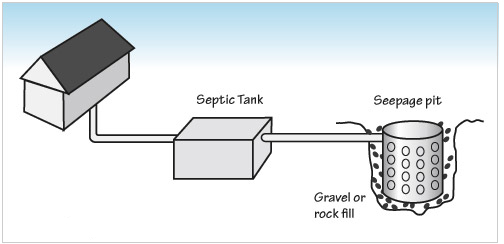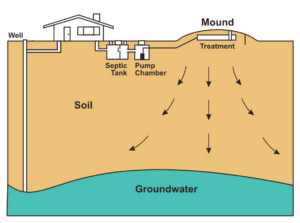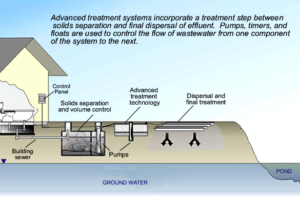Onsite Wastewater Treatment Systems (OWTS) Design
Each New OWTS must be evaluated individually to determine suitability, before a Permit to Construct will be issued. Evaluation is site specific. The type and size of OWTS is dependent on the bedroom equivalents and plumbing fixtures of the structure served by the OWTS, capacity of the tank, location, soil permeability, depth of groundwater, geologic features including presence of bedrock formations of concern, slope, hill stability, and waterbodies nearby.
Here are the application and supplemental materials you will need to submit for your new OWTS:
- Application for Onsite Wastewater Treatment System – PDF
- Geotechnical / Soils and Engineering Report prepared by a Qualified Professional
- Plot plan drawn to scale depicting all existing structures and proposed construction on the parcel in relation to the proposed OWTS , including septic tank, dispersal area, and 100% expansion area. Plot plan must also include features such as property lines, existing OWTS on the property, internal roads/driveways/paved areas, water wells, streams, trees, etc. (See Step 6 on page 2 of the Application).
- Floor plan depicting layout of proposed construction
- Bedroom Equivalents and Fixture Units / Bedroom Number Determination for Sizing OWTS – PDF
- Approved Zoning Clearance from Ventura County Planning
- CSA 32 – PDF (Alternative OWTS)
- Annual Maintenance Agreement (Alternative OWTS utilizing ATU’s)
Please provide all required materials. An incomplete submittal will delay the processing and/or approval of your application.
Install a Conventional OWTS
NOTE: If your home or business requires a conventional OWTS, but is located within 200 feet of an available public sewer utility line, you will be required to connect to pblic sewer.
Conventional Leach Line SystemsLeach lines distribute the septic tank effluent into the surrounding soil at a depth generally not more than six feet. They are typically long and narrow. This shallow dispersal system provides effluent disposal under aerobic conditions at a maximum distance from underlying bedrock or groundwater.
Conventional Seepage Pit SystemsSeepage pits consist of a drilled pit filled with drain rock through which the septic tank effluent is distributed via a central perforated pipe extending the full effective depth of the pit. Seepage pits should have a diameter of 4 to 6 feet, and the depth should extend no greater than 60 feet. Seepage pits are used when soil conditions near the ground surface are unsatisfactory for leach fields or when there is insufficient land area to install a leach field.
Install an Alternative OWTS
An alternative onsite wastewater treatment system contains the same basic components as a conventional OWTS (septic tank, distribution box, and leach lines or seepage pits), however, site conditions require you to install additional wastewater treatment features.
NOTE: If your home or business requires an alternative OWTS, but is located within ½ mile of an available public sewer utility line, you will be required to connect to public sewer.
The three types of alternative systems currently approved in Ventura County are mound systems, subsurface sand filtration systems, and OWTS which require supplemental treatment units for nitrogen and pathogen reduction.
- Mound Systems are typically used in areas with high groundwater. Mound System components include a lift pump and wet well, pressurized effluent piping, a sand fill mound, a distribution bed composed of gravel filter material and perforated distribution piping, and a cover of topsoil over the top and sloped sides of the mound.
- A Subsurface Sand Filtration System is used in areas where the character of the soil is fractured rock. Typical subsurface sand filtration systems include effluent piping, a subsurface distribution bed, a sand filtration bed, and a leach line, leaching bed, or seepage pit as the final dispersal field component.
3. A Supplemental or Advanced Treatment Unit (ATU) is used where site
- conditions or applicable effluent quality standards necessitate additional treatment. Supplemental treatment components for nitrogen reductions must meet NSF/ANSI Standard 245, and, must be inspected for proper operation by a qualified provider. Supplemental treatment components for pathogen reduction must meet NSF/ANSI Standard 245 or 40, and, must be inspected for proper operation by a qualified provider. Proof of a maintenance agreement by a qualified provider must be submitted annually to the Environmental Health Division.
Additional OWTS Design Information
- Septic Tank Sizing Criteria – PDF
- OWTS Setback Requirements – PDF
- Disposal Field Setbacks from Slopes and Fill Material – PDF
- Subsurface Filter Bed with Disposal Pit – PDF
- Basal Subsurface Filter Bed – PDF
- Example of OWTS Design Specification Sheet – Mound System – PDF
- Onsite Wastewater Treatment System Technical Manual – PDF





